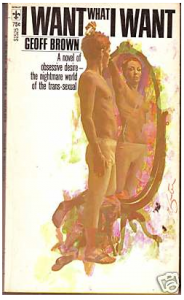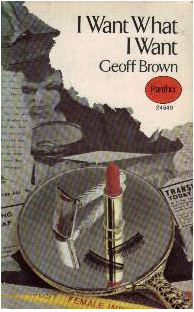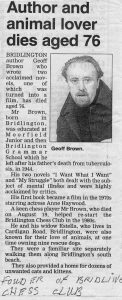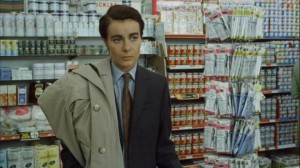The Hunt for Geoff Brown — Author of I Want What I Want
Willow Arune is a collector of books. Not just any books but signed first editions. She hunts up the author and has them sign her copy of their work, or a bookplate which she affixes to her first edition making it a signed first edition. One of the authors she decided to track down was Geoff Brown who wrote a novel in the early ‘60s called I Want What I Want. The main character is a male to female transsexual. Ms. Arune wrote about her quest to find Brown on 2007 on a blog where she publishes the stories of how she finds all the authors of first editions she has collected. She recently submitted the text of that blog to TGF and we present an edited version of it today.
 If you talk to a transsexual woman older than 40, chances are she remembers having read a novel that dates back to the 1960s by the strange title of I Want What I Want. Perhaps you have seen a black and white movie on late night television by the same name.
If you talk to a transsexual woman older than 40, chances are she remembers having read a novel that dates back to the 1960s by the strange title of I Want What I Want. Perhaps you have seen a black and white movie on late night television by the same name.
Most of us have.
What makes this book so very interesting is that it is the first — the very first – novel to deal in a realistic manner with a new minority then emerging — transsexuals. It dates back to 1966, the year before Christine Jorgensen published her autobiography and Dr. Harry Benjamin published his groundbreaking medical book, The Transsexual Phenomena Gore Vidal’s spoof Myra Breckenridge was not yet published — it would follow in 1968. (The first book, in the form of a novel but what we would today call a “fiction non-fiction,” on transsexuality was Man Into Woman, by Niels Hoyer an account of the first known sex reassignment surgery in 1931 Germany. Very rare, it was reprinted as a pocketbook in the early 1950s and recently reprinted in the UK by Blue Boat Publishers. Novels dealing with intersexed people are more common. From Gary Jennings and his Raptor to the 2003 Pulitzer Prize winning Middlesex by Jeffrey Eugenides and arguably many in science fiction).
I Want What I Want was published first in the United Kingdom, then in the USA. It made little impact. A late paperback copy was released in both countries, with not much more impact. The writer, Geoff Brown, was unknown and new to novels (I Want was his first and only one more would follow — that almost ten years later).
Still, the subject of transsexuality had been given many pages of print and a few salacious pocketbooks before 1967. It was not an unknown topic but viewed as a very strange one. In fact, as novels go, those that involve realistic portrayals of transsexual women are still rare. Those by males (Two Strand River by Keith Mallard in 1974, The Danish Girl by David Eberhoff and Trans Sister Radio by Chris Bohjalian in 2000) have made the trade press. Those by transsexual women writers such a Pamela Hayes are generally found, with great difficulty, amongst the publish on demand press.
So where did I Want What I Want come from? Who is the writer and is he (or she) dead? Did he transition?
From what is available, we know very little. In fact, as much as we know is contained on the back cover of I Want. “Geoff Brown,” we are told, “was born in Bridlington in Yorkshire in 1932 and still lives there. This is his first novel and he is at work on a second.” That second novel was in fact written and published, in 1975. On the blurb of that book, we find out a bit more, but not much:
Geoff Brown is a Yorkshireman he says he is stuck with it so he might as well be proud of it. When questioned, he said that he though he might be able to write what were taken for autobiographical novels, as yet he did not seem to have any autobiography of his own. In the photograph above [see below] it is just possible to discern the scar on the right side of his nose that resulted from a misunderstanding with a neurotic dog. (“I got my nose between his teeth and I wouldn’t let go”). His hobbies are chess, war games and jeering at certain television programmers.”
(Blurb from the cover of My Struggle” – the second and final novel by Geoff Brown)
That was in 1975. After that, nothing.
Two blurbs and silence.
 Formal reviews of I Want… were promising. Punch, Sunday Times, The New Statesman and Saturday Review used words like “promising,” charm,” intelligence,” “Powerful and moving, “honesty,” “compassion and glowing with truth.” For the 1960s, that was great! In fact, for any novel about transsexuality today, that would be wonderful!
Formal reviews of I Want… were promising. Punch, Sunday Times, The New Statesman and Saturday Review used words like “promising,” charm,” intelligence,” “Powerful and moving, “honesty,” “compassion and glowing with truth.” For the 1960s, that was great! In fact, for any novel about transsexuality today, that would be wonderful!
What the book did do is inspire a young actress to look upon it as her vehicle to stardom. Anne Heywood, a young actress with some film credits and a former Miss GB, saw I Want… as her excellent opportunity. She was in a position to do something about it as well, for her husband of the time was a film producer, Raymond Stross. Stross had many pictures under his belt in the UK. According to what is suspected, Anne put the flea in his ear and he bought the movie rights from Geoff Brown, hiring John Dexter to direct (Dexter would go on to win fame — and awards — on Broadway but I Want… was the last film he directed).
The Stross project moved ahead, as movies do, slowly. In the meantime, back in the YUUU ESSS AHHH, other movies were a-makin’ — and faster. Gore Vidal’s Myra Breckenridge had shocked the public, surprised his publishers (who even ordered cheap paper as they thought the book would fail) and become a movie with Raquel Welch which was released in 1970. On a more serious side, Paramount had bought the rights to Christine Jorgensen’s biography (saving her financial life at the same time) to make The Christine Jorgensen Story, also released in 1970. Both of those had a big advantage — they were each in living color. Poor I Want… was a black-and-white film. (Editor’s Note: The Internet Movie Database says that the film was released in Eastman color.)
Poor Myra. Vidal was hired to do the screenplay and then replaced. The effort was to decline even more:
Rex Reed says that MYRA BRECKINRIDGE was a film made by a bunch of people who hid in their dressing rooms while waiting for their lawyers to return their calls.
The film itself demonstrates the accuracy of these comments. The basics of Vidal’s story are there, but not only has the story been shorn of all broader implications, it seems to have no point in and of itself. Everything runs off in multiple directions, nothing connects, and numerous scenes undercut whatever logic previous scenes might have had. And while director Sarne repeatedly states in his commentary that he wanted to make the film as pure farce, the only laughs generated are accidental.
User Comments” from IMDB
I Want… had a happier time with the screenwriter. Brown was not up to the task, although he is credited. An English novelist, one who created a stir when she wrote the first classic book involving homosexuality (Leather Boys), Gillian Freeman was set to work. She had worked with Stross before, bringing her own book to the screen, but this was different and she should have known better. After all, the star was Anne Heywood, who just happened to be married to Stross. By the time it all ended, both Brown and Freeman thought they were off the hook for the result. The producers (i.e. Stross) had changed everything.
Transsexuality was a tough subject back in those days and remains so today, even with Boy’s Don’t Cry and Transamerica, so by the time I Want… hit the screens, the topic as well as the b&w treatment sank like a stone. Still, transsexual women who saw it, including myself, considered it a classic.
Making matters more confusing for anyone who cared to look, there were several other “Geoff Browns” who elected to write books on Black music, biking and other subjects. The name is certainly not uncommon. After his second novel failed to generate many sales, our Geoff Brown simply stopped writing and disappeared from view.
For over 25 years…
I had seen I Want… on late night television (it was actually on at 2:30 a.m., but as a transsexual woman, I stayed up to watch). Being a bookaholic, I wanted and finally found a copy of the first edition, which was becoming rather pricy by 2000. Even the paperback copies were going for over $50 by then, although thinking Brown was dead had the book show up free on the Internet, reproduced without concern for royalties, I suspect. After hunting down one Geoff Brown after another, none of them the “right” Geoff Brown, I had pretty well given up when my partner and I moved north to Prince George, some 700 miles north of Vancouver. (“You left Vancouver, the world’s most livable/wonderful/best traveller’s/best business traveller’s city!?” Yep. Getting too pricy, trendy and too warm. We needed cheap, basic, and cold. Just our luck to move north when global warming gave Prince George the warmest winter on record. We may have to head further north soon…).
After the move, I revisited the matter of the missing Brown. As publishers and more had failed me, I headed off in another direction — after the movie types. Now, Stross was dead. Anne Heywood had moved to the USA, married a former NYC D.A. and moved to Hollywood, made many more films with small roles up to 1988, and then… Nothing.
All of the other members of the cast had died, it seemed. But then, a bit of luck. I found that Gillian Freeman had published a new book, her tenth. I write to her publisher (a very small publisher on the English coast), itself a bit of a strange step, and got back word that Gillian had had a stroke, but that her publisher, the dear, would copy my post and send it on to her for reply.
Several weeks past. Then the postie brought a rather thick envelope postmarked from the UK. It was from Gillian. Unable to type after her stroke, she had kindly taken the time to dictate a letter and have her husband type it! Even better, she had not given all her papers to Reading University, as my Internet research had disclosed, but had kept some. She enclosed with her letter copies of letters she had received from Brown during the writing, filming and release of I Want What I Want, the movie. The bad news was the last correspondence she had with Brown was back in the 1970s. She had no idea of where he was — dead or more likely transitioned with a new name, she thought.
My many trips to England had taught me some of the local culture. One fact I remembered. We here in North America pull up stakes and move every second year, it seems. However, in the UK, many people live all their lives, from birth to death, in the same house. Brown’s letters to Freeman, from the 1970s had a return address. Was it possible?
A bit more Internet digging. A search for the town and it has a bulletin board! Therefore, I asked if someone would look up Geoff Brown in the local telephone directory — just to tell me if one was shown at the old address. A reply came back in a few hours. “G. Brown” was listed. Another search with Brit Mail and Brit telephone gave me the postal code and telephone number.
Delighted, I even look up a map of the town, to pinpoint Brown’s home, nosey parker that I might be.
And I wrote a very nice letter.
And I waited…
A week passed. Then two. During that short time, my partner and I changed our phone plans and could now phone anywhere in the UK for a mere $.10 per minute. I did have Brown’s telephone number, thanks to Brit Telephone. With temptation steering my course, I picked up the phone one morning (allowing for the time differences and such) and dialed the number, getting the distinctive British telephone ring.
It was picked up!
“’Allo. Who’s this?” said a decidedly elderly female voice.
I introduced myself and stated my purpose.
“Oh, you’re that Canadian who write to my Geoff, are you? Oh yes, he got your letter. Matter of fact, he’s up stairs now writing a reply. I’m his wife.”
Now, the voice was a tad cold and unfriendly, but even finding that Geoff had a wife and was thus, presumably, still a man was a step forward. I asked if I could speak with him directly.
“Auw no. He’s up the stairs, isn’t he? ‘ad his supper and went back up stairs. Can’t get him downstairs now, where the tele is.”
Having some experience with the elderly and a little with the narrow old English staircases, I could appreciate that this might be difficult. Still, I had to gain some ground with this formidable character. Now, when confronted with this type of wall, I cast about with subjects, hoping to establish some rapport. I hit on the third — dogs.
“Oh yes, dogs are nice. Geoff and I have three big dogs” and Mrs. Brown and I were on our way to establishing a nice relationship.
Through our brief conversation, I found that Geoff had only written two books, been dissatisfied with the results, so simply ceased writing. He still lived in the same house where the book had been written, some thirty plus years after. In fact, I suspect he was born in the same house, the same town, and the same room! Mrs. Brown and I had a nice little chat and she promised that she would see to it that Geoff did indeed reply to my letter. The amazing thing was that he did!
Now, pause there. Here is a man who wrote two books, had no continuing interest in either the books or writing, and who suddenly gets a letter then a call form across the seas about the damn thing, filed long away in the past.
The next week, the postman brought another letter from England, this one from Mr. Geoff Brown himself. Not only did he send the letter, but also it was obviously typed on the same typewriter that had been used for the correspondence with Gillian Freeman, back in the 1970s. In fact, it looked like the same typewriter ribbon!
History in my hands.
Now, Geoff signed some bookplates for my copies of his two books, thus making mine the only autographed copies of the Complete Works of Geoff Brown, something only a book collector could appreciate or even understand. Attempts to ferret out more concerning how he had come to write such a book were fruitless. In fact, after some attempts, I finally tried to enlist the aid of the Gender Trust of the UK, writing to them and suggesting they do an interview to record some of our history, scant as that is, as a minority. They did indeed delegate someone to do so, but a solid brick wall emerged when they wrote to set up the interview. Geoff replied that he had once granted permission for an interview, but the two fellows who showed up to complete the task were officious, in white shirt and dark suits, and were in his belief either CIA or FBI. Naturally, that removed any chance for a further interview. He had tried it once, then books were tried twice, and he did not need to repeat the performance.
So, we know that Geoff did not transition, is married, has three big dogs, and… What else? Well, The second book, My Struggle is rather like One Flew Over the Coo Coo’s Nest. Geoff writes the book from inside the mind of a schizophrenic, and it is a chilling read indeed. One example — the young hero is playing with his brother when parents are away. For fun, he ties his brother to the staircase railings and then tortures him. His parents, upon their return, are upset. “Why?” he wonders. Just a nice thing to do on a slow boring day.
Geoff has lived all his life in a small seaside town. While I cannot say this for sure, certain indications suggest that he lives in the hours his parents lived in. During his late teens, a shipwreck just off the coast had a profound impact on young Geoff. The large fishing vessel had run aground on a reef and was pounded for days before it sank with all hands. Rescuers could not scale down the steep cliffs in the bad weather. This real incident plays a role in Geoff’s second book and certainly for a time during the 1970s was an obsession. He wanted to write a new Moby Dick using the wreck of the Skegness. That book was never written; instead, the news reports of the sinking appear as a close to My Struggle A book that Geoff “blames” on an American editor who had joined the publishing house.
Geoff has never seen the movie version of I Want… — not even today. When the movie was being made, he had sided with the producer to use a female to play the lead. Gillian had wanted a male actor. The producers ripped apart Gillian’s screenplay and Geoff’s book, as Geoff and Gillian agree.
Well and good, the mystery remains. This book was written in 1964 (publication was two years later) at the height of the Beatle craze. There was almost nothing publish on transsexual treatment or sex reassignment surgery outside of the press — no books, autobiographies, or medical studies. Geoff was married at the time. How was Brown able to convey so much of the transsexual world from a small coastal English town? Did he, as Gillian Freeman suggests in one letter, want to transition, to become a woman? Did he know those that did? There were few transsexuals in England at that time. April Ashley was certainly known but few others and, I suspect, none at all in Brown’s location. Still, the book clearly shows a rather close understanding of what a transsexual feels and the options then coming available.
 Both of his books do show a very intimate knowledge of the subject and it could be that such was his special talent — taking the imagined life of others and making it real on paper. Contrary to that concept, many first novels are highly autobiographical. The locations used in I Want are certainly drawn directly from Geoff’s own “neck of the woods.” If I Want… was solely imagination, where did he find out more? No books were available, as none had yet been printed.
Both of his books do show a very intimate knowledge of the subject and it could be that such was his special talent — taking the imagined life of others and making it real on paper. Contrary to that concept, many first novels are highly autobiographical. The locations used in I Want are certainly drawn directly from Geoff’s own “neck of the woods.” If I Want… was solely imagination, where did he find out more? No books were available, as none had yet been printed.
We shall never know. Geoff Brown is over seventy now and not about to grant an interview. There are few hints in the book itself. What makes that even more a mystery is that few in England at that time would even know about transsexuality, let alone sex change operations which were not then legal in the UK. Where did he get his inspiration and information? A newspaper article? A copy of Man Into Woman that turned up in a bookshop?
The mysteries posed by Ms. Arune will never be answered. Geoff Brown passed way at the age of 76 on August 20, 2008. Willow Arune is a retired lawyer, avid book collector and presently an M.A. candidate in History at the University of Northern British Columbia.
You can read I Want What I Want online for free at antigen.org.
Category: Transgender Fun & Entertainment, Transgender History




